The beautiful landscape of the Isle of Mull is dotted with tiny burial grounds, each of them with their own stories to tell. We’ve already visited Pennygown, with its ruined chapel and graves ranging from the medieval period to the present day. Some of these cemeteries are close to settlements, others seemingly in the middle of nowhere. They are all in stunningly beautiful locations. The words and symbols preserved on the gravestones offer us a glimpse into the history of the island, and of the lives of the people who have lived and died there over the centuries.

Dervaig is one of the larger settlements on Mull, overlooking an inlet which gave the settlement its name (Dervaig means “good inlet” in old Norse). The heart of the village was laid out at the end of the 18th Century, but the area has been settled for much longer than that – there are a few prehistoric standing stones on the hillside above Derviag; and when driving out of Dervaig towards Tobermory, the ruins of an old village, abandoned at the time of the Clearances, can be seen. The burial ground at Dervaig is situated above the village’s houses and church; quite a long and steep walk, particularly for any coffin-bearers!

A chapel was first constructed on the site in about the thirteenth century – later, a new church serving Dervaig was constructed further down the hill, on the site of the present Kilmore Church. Some graves are surrounded by low walls – perhaps some of these structures were once part of the chapel on the site.

Quite a lot of the graves in this cemetery are in their own little enclosures, which fence off family plots from the rest of the burial ground. Within these enclosures it is not unusal to see gravestones of differing ages and styles, reflecting the fashions or personal preferences of different periods.

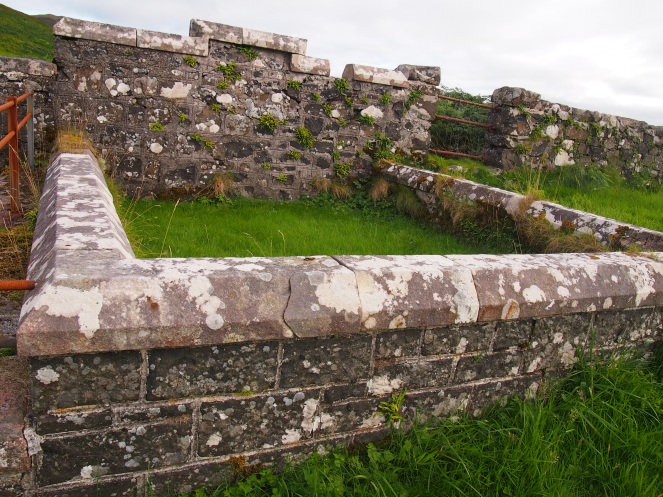
A number of military graves can be found within the cemetery, some commemorating local men who died far from home, others marking the final resting place of unknown sailors whose bodies were washed up nearby.


The gravestones at Dervaig date from the polished granite memorials of the 20th Century back to the worn, unreadable and possibly even medieval. New burials no longer take place there, as there is a newer cemetery in the area, but this burial ground received the remains of many, many generations of people who lived in and around Dervaig.


Some of the smaller gravestones at Dervaig are disappearing into the soft, deep grass that carpets the cemetery. As I explored the site, I was struck by how uneven the ground was. That is undoubtedly in part due to the hillside location of the burial ground, and the rocky landscape. But underfoot I could discern the shapes of small, flat stones; forgotten graves that are sinking deeper into the hillside.


If one continues along the single-track road heading west from Dervaig, the isolated and rather stunning bay of Calgary eventually comes into view. With its white sandy beach and wild campsite, it’s a popular spot for visitors to the island to stop off and enjoy the scenery.
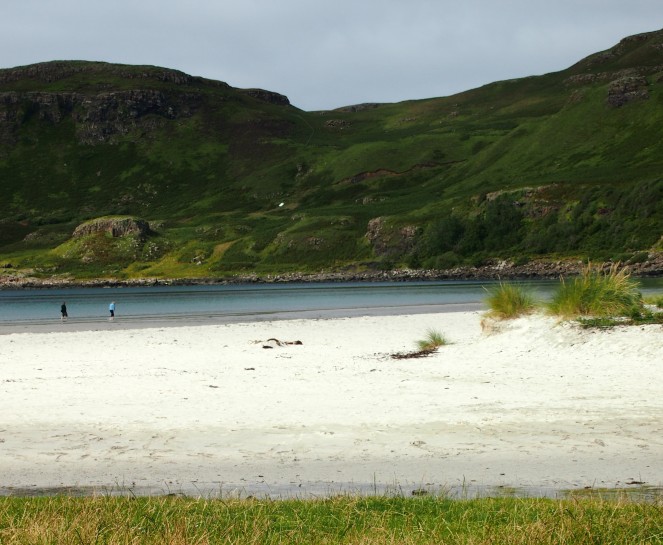
Calgary gave its name to the more well-known city in Canada, which began to develop at the end of the nineteenth century. Mull’s Calgary, on the other hand, is a tiny settlement of just a few houses. Before the Highland Clearances, when many people were forced off the land to make way for more profitable sheep farming, the population of the area was larger, with those residing in this beautiful place including some of the ancestors of the actor David Tennant, who lived in the now-ruined settlement of Inivey. Although most of the people who once lived here are now gone, Calgary’s little graveyard still remembers them.

The grave pictured below on the right, belonging to members of the MacLean family, commemorates a son of the family, Donald, who died aged 29 at Calgary in Canada. Perhaps he was drawn to the Canadian settlement due to it sharing a name with his family’s home on Mull?

The grave markers in this peaceful little burial ground range from very simple stones without inscriptions to elaborately-carved memorials that clearly cost quite a bit of money.



A number of flat gravestones, dating from the 17th or 18th centuries, have prominent skull and crossbones carvings.

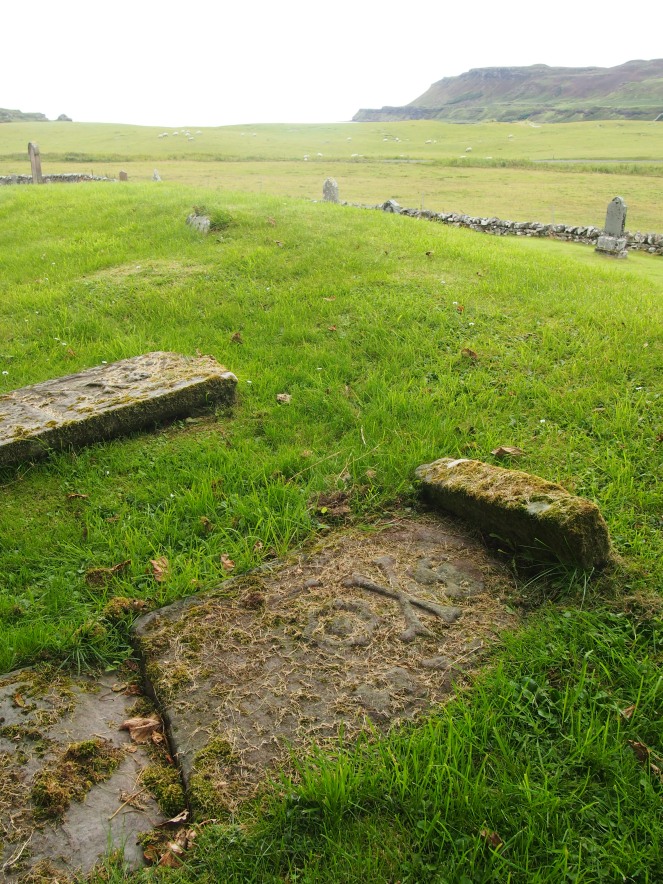
Many of the people living in the remote communities around Calgary had their lives turned upside down in the early 19th Century, when landowners began to evict people from their land to make room for sheep farming, which was at the time a more profitable use of the land. This time is known as the Highland Clearances, as it affected many communities in the Highlands and Islands of Scotland. The people who found themselves turned out of their homes moved to growing industrial cities such as Glasgow in search of work, or sought a new life altogether across the Atlantic. Perhaps some of the people, like young Donald MacLean, whose ancestors lie in the little burial ground at Calgary found their way to Calgary in Canada.

At Duart Castle, the seat of Clan MacLean, there is a small burial ground where members of an occupying English garrison and their family members were buried during the 18th Century. They had requested a separate burial ground as the men did not wish to bury their comrades in the “heathen” cemetery for local people. This “heathen” burial ground could well be the little graveyard that one drives past on the way to Duart Castle. A new burial ground, currently with just a single row of modern graves, has been set out between the old burial ground and the road.
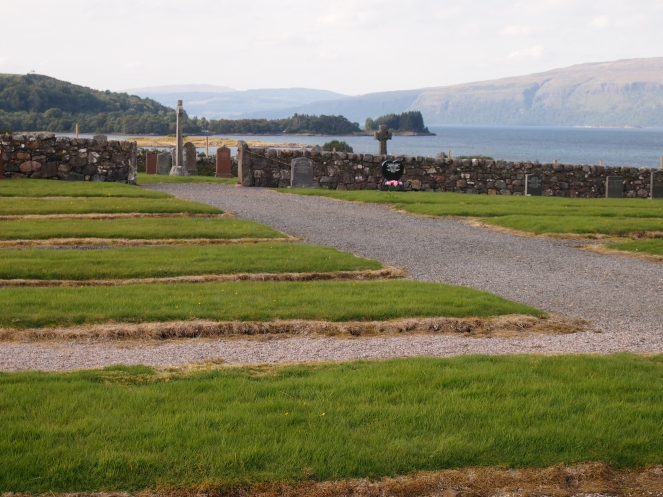

The earliest legible grave in the cemetery dates from 1707, but the name of this burial ground – Kilpatrick – suggests that it might once have been home to a chapel dedicated to St Patrick. There is a grave surrounded by walls but this structure may be a purpose-built enclosure for the grave, such as some of those seen at Dervaig.
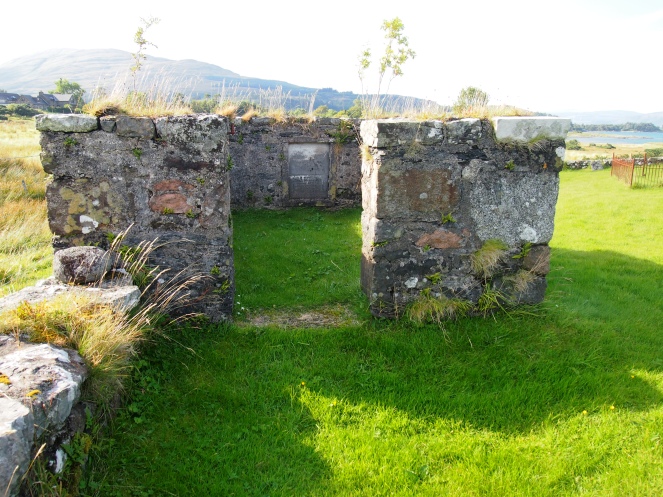
One of the most prominent graves in the cemetery is that of Sir Fitzroy MacLean, who died at the grand old age of 101 after purchasing and restoring Duart Castle, bringing the castle back into the the ownership of Clan MacLean after two hundred years.

One of the older headstones has a wonderful memento mori carving on its back.
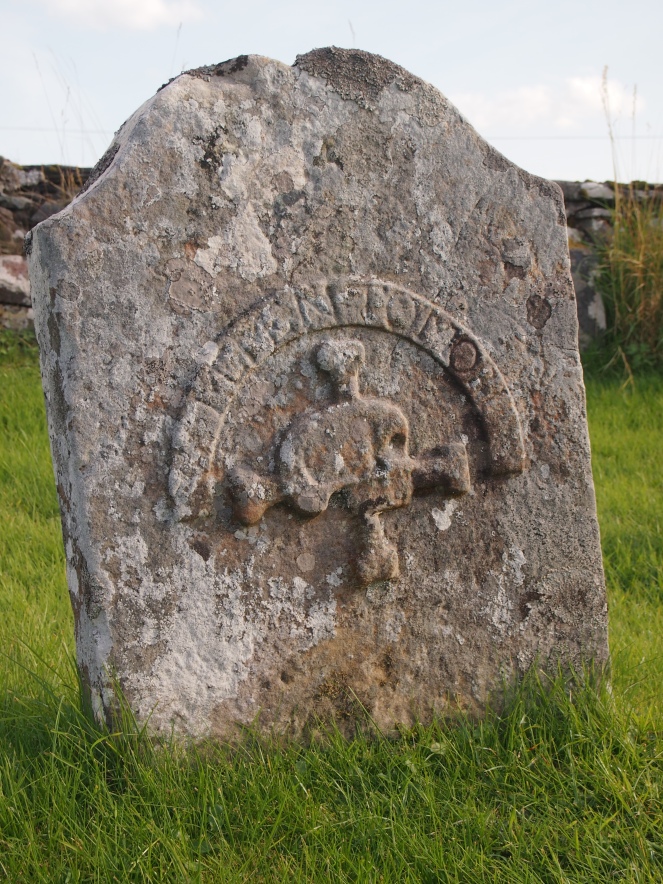
Like the other burial grounds we’ve visited in this article, the peaceful spot near Duart Castle contains gravestones from a multitude of different periods, ranging from the plain to the elaborate. Although the area is sparsely populated, the large modern extension to the burial ground shows that it is in demand as a final resting place. It is hardly surprising, given the beautiful views from the cemetery and the overwhelming atmosphere of peace.




Although the old burial grounds of Mull are less well-documented than, say, the big Victorian cemeteries in British towns and cities, they have a unique charm and their stunning locations make them incredibly atmospheric places. Many of the people buried in these places were part of a way of life that disappeared long ago. Although few of the tourists who visit Mull stop to visit these little burial grounds, they are surely some of the most picturesque and poignant reminders of that beautiful island’s past.
References and further reading
Mull Historical and Archaeological Society – Burial Grounds http://www.mull-historical-society.co.uk/churches/burial-grounds/
Dervaig – Undiscovered Scotland http://www.undiscoveredscotland.co.uk/mull/dervaig/
Calgary – Undiscovered Scotland http://www.undiscoveredscotland.co.uk/mull/calgary/index.html


Thank you for the wonderful article and pictures.
LikeLike
Thank you!
LikeLike
Stunning location for a resting place! Lovely lichens too! Thanks for posting!
I walked around two cemeteries this week in Birminghams Jewellery Quarter, Key Hill and Warstone Lane. The catacombs were amazing, but I couldn’t find where Baskerville, he of the typeface, was interred as there was no plaque which is sad given his legacy to lettering! Thoroughly recommend them if you are that part of the country.
LikeLike
Thank you! It was great to visit so many beautiful cemeteries whilst visiting Mull.
I am hoping to visit the cemeteries near the Jewellery Quarter in Birmingham some time soon – they sound like really fascinating places.
LikeLike
Great post, but you really need to go the Outer Hebrides, start at the bottom and work your way up….you would have such a fantastic time 🙂
LikeLike
I really would! One day I get the money together to spend a summer visiting the Outer Hebrides and all the cemeteries, ruins and stone circles they have there 🙂
LikeLiked by 1 person
A beautiful post, Caroline! Such lovely places, and you’re right about the efforts of the coffin bearers! You’ve made me want to re-visit Calgary Bay. I remember finding a lovely old graveyard with a ruined church at Kilvickeon, in the Ross of Mull. Fabulous place.
LikeLike
I would love to go to Kilvickeon. It was on my list of places to visit when I was last in Mull but we didn’t go that far into the Ross of Mull – I think Lochbuie was about as far as we went in that sort of direction!
LikeLiked by 1 person
Mull is surprisingly big! You need a week at least to explore it.
LikeLike
A picturesque cemetery indeed! Love your photos, and how cool are those memento mori?!
LikeLike
Thank you! I love a good memento mori, and the one I found in the graveyard near Duart Castle is one of the best I’ve come across so far.
LikeLike
I have posted a page link on the Clan MacKinnon Facebook page
LikeLike
What a lovely place! Thank you for your beautiful photos and thoughtful writing. Looks like another place I should add to my list of cemeteries to visit.
LikeLike